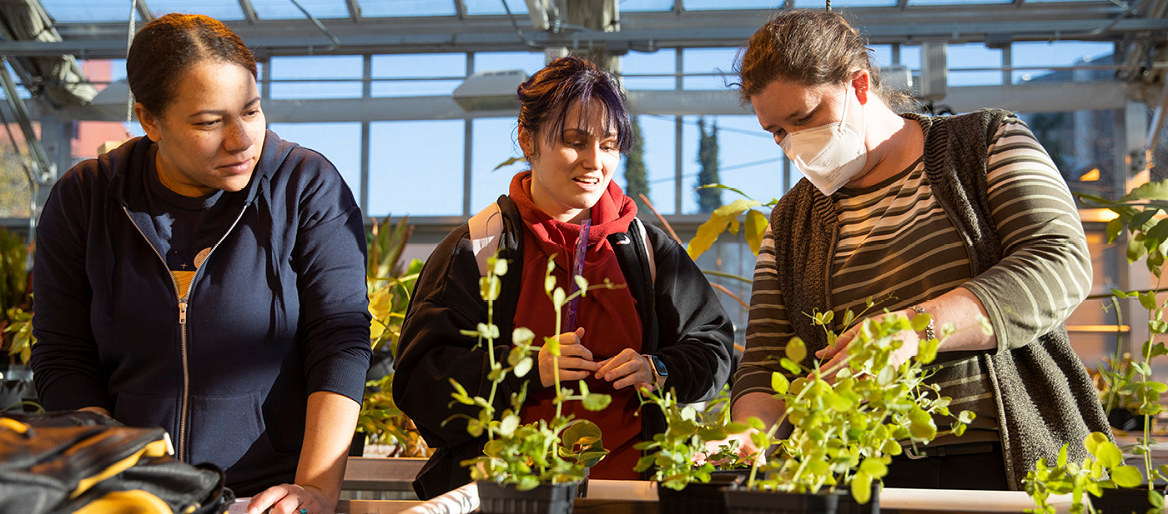Biology class participates in research project

Beautiful mutants: a PLU biology class harvests for the future
By Lora Shinn
Marketing & Communications Guest Writer
About two years ago, PLU professor Neva Laurie-Berry partnered with a world-class plant research center. The Donald Danforth Plant Science Center in St. Louis, Mo., sends Laurie-Berry’s BIOL 358 Plant Physiology class millet seeds with random mutations. Student teams study plants in PLU’s warm, sunny greenhouse, watching for genetic traits that help millet grow taller or produce more seeds.
“The Danforth Center is crowdsourcing genetic research,” Laurie-Berry says. “We’re helping Danforth go through thousands of seeds, identifying which are worth studying. No one knows how each one will behave.” PLU students are joining high school and undergraduate students in analyzing lab-generated mutant seed populations in partnership with Danforth.
Students care for the plants, recording the number of seedheads produced and any branches or unusual seedheads or leaf shapes. At the semester’s end, students collect seeds from each millet plant to mail back to Danforth, along with their findings.
Expanding knowledge and opportunity
The Mutant Millets project refines Setaria viridis, a small, hardy grass that grows wild throughout North America. Otherwise known as green millet, the grain is a high-protein food staple and more nutritionally dense than rice. The National Science Foundation and other funding sources support the project.
“Although millet is a culturally and nutritionally important food in Asia and Africa, it’s not commonly grown in western agriculture, so there’s not a lot of research,” Laurie-Berry says. A similar process of genetic experimentation refined rice production around 50 years ago. “After we figure out which genes control yield, the center will cross-breed those traits into disease-resistant varieties adapted for growth in India or Africa,” she says.
The research exemplifies how the PLU sciences strive to offer novel research opportunities to any biology minor or major. Laurie-Berry says that summer research programs often present students with the only chance to do hands-on, original research—which means participants need 10 summer weeks free to be in the lab. This isn’t easy for those with summer jobs or other commitments.
“Offering student-faculty research opportunities to a broader range of students is important to me and our department,” Laurie-Berry says. “I was thrilled to bring meaningful plant science research into a classroom and to be able to say, ‘Here is the kind of work people are doing, and you can be part of that.’”
From seed to sprout
Laurie-Berry first became familiar with the Danforth Center‘s work while completing her Ph.D. in molecular genetics at Washington University in St. Louis. At Danforth, nearly 300 scientists from more than 20 countries work in teams, studying plant biology in ways that lead to economically and environmentally sustainable agriculture.
Laurie-Berry started teaching at PLU in the fall of 2008. In addition to Plant Physiology, Laurie-Berry’s other classes include Plant Development and Genetic Engineering and a first-year writing class focused on global agriculture, world hunger, genetic engineering and related topics. “Our central question for the course is how agriculture and related systems must change to alleviate global hunger,” Laurie-Berry says.
Before 2015, the original PLU greenhouse functioned more like an extremely hot sunroom built on a black flat top roof. “It got so hot that everything died,” Laurie-Berry says. “The new greenhouse completely transformed what I could do in that class.” Today’s Carol Sheffels Quigg Greenhouse was built in 2015 and named for a former PLU regent, donor and enthusiastic supporter of science education at PLU.
The 1,700-square-foot facility boasts an innovative closed-loop, geothermal energy system to create a sustainable, energy-efficient building. Multiple benches contain different growing spaces, with infrastructure that can help regulate temperatures and light.
Dr. Romey Haberle, one of Laurie-Berry’s colleagues, maintains a collection demonstrating evolutionary plant history and diversity. Cacti, carnivorous plants, corpse flowers and tropical trees all flourish within the greenhouse.
Angles and answers
Laurie-Berry’s greenhouse BIOL 358 students note leaf angles of corn plants with random genome mutations and measure sunlight that’s effectively captured without shading other corn plants. Ideally, results could increase the yield of corn per acre, “important as land space becomes a scarcer resource as the population grows.”
Students measure with protractors and free National Institutes of Health software, then send images and measurements back to Danforth to determine which corn seed stocks are worth further investigation.
Students often expect a “right answer” in undergraduate labs, but discover there may not be one. “It’s confusing and freeing for them to hear that even I don’t have the right answer and don’t have a key,” Laurie-Berry says. As a result, students gain ownership and responsibility for contributing data toward real-world global plant biology.
Inspired by the class, some students have gone on to specialize in agricultural sciences and biotechnology. “It’s so exciting to see someone get passionate about plants, make connections, and go further with it,” Laurie-Berry says. “Even for students who go on to medical school or cancer research, this research brings them a broader appreciation and lens for their future work.”



Social Media